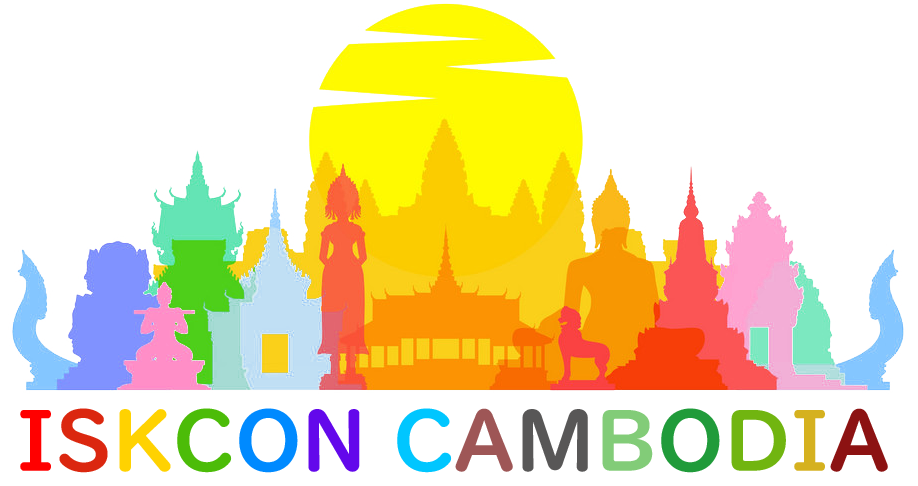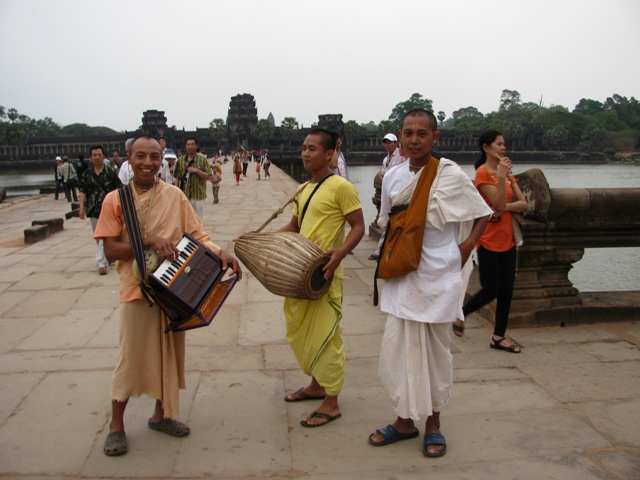We hear about how devotees are meant to always enjoy in the transcendental service of the Lord. But how is this possible, because normally living in this material world is very troublesome. In this short article, we will try to analyze a few interesting points in relation to this.
Devotees acquire the thirty qualifications of human being
The Srimad Bhagavatam 7.11.8-12 mentions the thirty qualifications of a human being as follows: truthfulness, mercy, austerity (observing fasts on certain days of the month) bathing twice a day, tolerance, discrimination between right and wrong, control of the mind, control of the senses, nonviolence, celibacy, charity, reading of scripture, simplicity, satisfaction, rendering service to saintly persons, gradually taking leave unnecessary engagements, observing the futility of the unnecessary activities of human society, remaining silent and grave and avoiding unnecessary talk, considering whether one is the body or the soul, distributing food equally to all living entities (both man and animals), seeing every soul (especially in the human form) as a part of the Supreme Lord, hearing about the activities and instructions given by the Supreme lord, hearing about the activities and instructions given by the Supreme Personality of the Godhead (who is the shelter of the saintly persons), chanting about these activities and instructions, trying to render service, performing worship, offering obeisance, becoming a servant, becoming a friend, and surrender one’s whole self to the Supreme Lord.
Unless one is educated in these qualities, there cannot be any peace. Ultimately it is recommended (SB 7.11.12):
sravanam kirtanam casya
smaranam mahatam gateh
sevejyavanatir dasyam
sakhyam atma-samarpanam
Everyone should become a devotee of the Lord because by becoming a devotee of the Lord one automatically acquires all the others qualities:
yasyasti bhaktir bhagavaty akincana
sarvair gunais tatra samasate surah
harav abhaktasya kuto mahad-guna
manorathenasati dhavato bahir
“In one who has unflinching devotional service to Krishna, all good qualities of Krishna and the demigods are consistently manifest. However, he who has no devotion to the Supreme Personality of Godhead has no good qualification because he engaged in the mental concoction in Material existence, which is the external feature of the Lord.” (SB 5.18.12)
As we come to know from sastra, our character will develop according to whom we associate. If we associate with a thief we will acquire the qualities of a thief but if we associate with a saintly person we will acquire the qualities of that saintly person. And if we associate with the Supreme Personality of Godhead Krishna, then automatically we will acquire the Lord’s divine qualities that are known as “sat cit ananda”, full of eternity, full of knowledge, and full of happiness. Actually, those qualities are our real qualities, our original nature, and our real character as a spirit soul, because we are part and parcel of Krishna.
Now the question is how to link our devotion to Krishna and how to develop the service attitude to Krishna because the conditioned souls have forgotten their relation to the Lord since so many births. The conditioned souls are covered by the bodily consciousness of passion and ignorance, always engaged in activities of sense gratification that are always keeping them apart from the Lord.
The Srimad Bhagavatam mentions that we all have an eternal occupational duty, that natural occupational duty being devotional service to the Lord. By engaging in our eternal occupational duty of service to the Lord and thus completely satisfying the self one will ultimately gain liberation from the material sufferings.
Toward the Supreme occupation/duty
In the Srimad-Bhagavatam, 1.2.6, it is stated:
sa vai pumsam paro dharmo
yato bhaktir adhoksaje
ahaituky apratihata
yayatma suprasidati
“The supreme occupation (dharma) for all humanity is that by which man can attain to loving devotional service unto the transcendental Lord. Such devotional service must be unmotivated and uninterrupted to completely satisfy the self.”
“One should, therefore accept the superior quantity of occupation in the form of devotional service of the Lord without any tinge of unnecessary desire, fruitive action and philosophical speculation. This one can lead one to perpetual solace in His service.” Must give reference to this verse….
This eternal occupational duty, which is known as Sanatana Dharma, is the eternal character of the soul, and by acting according to that duty, a human being will achieve eternal happiness because he will be linked with the Supreme Lord Krishna.
Dharma is divided into two levels according to the stage of the soul. The first Dharma is for the liberated soul in relation to God and is called Bhagavad Dharma. The second Dharma is for the conditioned soul in relation with the social occupation and spiritual activities and it is called Varnasrama Dharma. Both are eternal occupations, because both are eternal systems given by the Supreme Lord. From these two occupational duties come two forms of devotional service. The first is Raganuga Bhakti (spontaneous pure love to Krishna) that is the stage of Bhagavad Dharma; the second is Sadhana Bhakti (development of love and service according to certain rules and regulations) that is the stage of Varnasrama Dharma.
Now we will make a few more points relating to Sadhana Bhakti, and of course, about the system that Krishna has created, “varnasrama dharma”. This social system of varnasrama dharma is mainly to bring one to Sadhana Bhakti and thus help establish peace in society. Varnasrama dharma is the transformation of Sadhana Bhakti. It is based on various rules and regulations for the human kind. The Varnasrama system is closely linked to education with the goal to achieve self-realization, then gradually persons can come to the level of Prema Bhakti. So even if we live in the material world we can learn to detach ourselves from sinful activities, fruitive result of work, and dry speculation. We can gradually be purified in consciousness and attain the full realization of the Absolute Truth namely Brahman, Paramatma and Bhagavan.
In this material world, the living entities are bound by the tree modes of material nature, and without Krishna consciousness their activities will only give fruitive results, and force them into repeated birth and death. Krishna says in the Bhagavad-gita that we should surrender all works unto Him, and do the work according to what He instructed. That will bring our purification and naturally persons will become happy, because that is our real natural position /occupation.
Natural Social Occupations
When we are living in society we should surrender the result of our work unto Krishna, or we can also work for Krishna Society, in the association of Krishna devotees.
Bg 3.30
mayi sarvani karmani
sannyasyadhyatma-cetasa
nirarsir nirmamo bhutva
yudhyasva vigata-jvarah
Therefore, O Arjuna, surrendering all your works unto Me, with full knowledge of Me, without desire for profit, with no claims to proprietorship, and free lethargy, fight.
Bg 3.31
ye me matam idam nityam
anutishanti manavah
sraddhavanto nasuyanto
mucyante te pi karmabhih
Those persons who execute their duties according to My injunctions and follow this teaching faithfully, without envy, become free from the bondage of fruitive actions.
Because the social occupations are in themselves a transformation of Sadhana Bhakti, so they should not be performed for material gain or sense enjoyment, but for satisfying Lord Visnu, Krishna. In this way Krishna must be the center of society, and everybody should be engaged according to what Krishna instructed in keeping with Guru, Sadhu and Sastra.
In the Bhagavad-gita Lord Krishna instructed to Arjuna to perform his duties as a Ksatriya, then Krishna explained the four varnas: Brahmana (for self realization, education and training), Ksatriya (for protection, administration and welfare) Vaisya (for agriculture, cow protection, and trade) and Sudra (for serving to other Varnas). These are known as varnas; the social occupation which one takes up according to His mood and activities. At the same time a person must surrender the work for Krishna, and of course with the chanting of holy names, the Hare Krishna Maha Mantra.
SB 1.2.9
dharmasya hy apavargyasya
nartho rthayopakalpate
narthasya dharmaikantasya
kamo labhaya hi smrtaha
“All occupation engagement are certainly meant for ultimate liberation. They should never be performed for material gain. Furthermore, according to sages, one who is engaged in the ultimate occupational service should never use material gain to cultivate sense gratification.”
SB 1.2.10
kamasya nendriya-prithi
labho jiveta yavata
jivasya tattva-jijnasa
nartho ys ceha karmabhihi
“Life’s desires should never be directed toward sense gratification. One should only desire a healthy life, of self-preservation, since a human being is meant for inquiring about Absolute Truth. Nothing else should be the goal of once work.”
Spiritual activities of Asramas
In the Bhagavad-gita, Lord Krishna mentions that practice of religion should go hand in hand with the study of philosophy. Religion is about certain rules and regulations for purification of the human being, and philosophy is about studying the Absolute Truth to rise up from the illusion of the material energy up to the stage of God consciousness. Practicing religion along with studying the philosophy of the Absolute Truth is one definition of Sadhana Bhakti. In this way a devotee acts according to proper knowledge about the Supreme, then he follows nicely the religious principle to keep himself aloof from the material contamination. All his activities are related to God, and 24 hours he fully remembers Krishna for his whole life.
In the Varnasrama system, there is Asrama, which we should understand as long life education towards self-realization. The Asramas are divided into four: Brahmacari life (student life), Grihastha life (family life), Varnaprastha life (retired life) and Sannyasa life (renounced life). These four stages or asramas form the entire process in ones life. These Asramas are meant for the performance of spiritual activities, and they can give the spiritual powers to perform the social occupation.
In the Seventh Canto of the Srimad Bhagavatam (Chapter 11) Narada Muni explains about the natural character and natural duties of all the varnas. He also explains that from the varnas come the asramas.
If a person is a brahmana he is allowed to enter all the asramas. If a person is a ksatriya he can take up three asramas (except Sannyasa), if he is a vaisya he can take brahmacari and grihastha life, and if he is a sudra, he can only take the grihastha asrama. In every asrama there are spiritual activities that one must perform. As stated in the Srimad Bhagavatam, the brahmacari should live with the Guru, study the Vedic mantras, control his senses and avoid the association of women. The Grihastha asrama is a kind of license for sex life, but not for unrestricted sex life. Householders must perform the Garbhadhana Samskara and other samskaras as well such as giving in charity. In the Vanaprastha stage, one should retire from family life and perform some austerities. The Sannyasis should propagate the message of the Lord. Situated at the topmost position in the varnasrama society, the Sannyasi guides the people towards self-realization in Krishna Consciousness
In some urgent situations, people of other varnas may take the role of Brahmanas to teach Krishna Consciousness. However, gradually the natural development of varnas should be developed, otherwise there will be a lot of disturbances in society. In addition, if we do not set up this Varnasrama system there will be no development of the natural character of the human being, there will be no proper engagement of neither the social occupation duty nor the spiritual activities, and people will continue to be engaged in wrong activities that will bring no peace in society.
Writed by: Gunaavatara dasa


Recent Comments